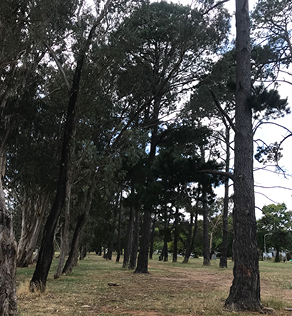In expectation of a cemetery that was never built
(The Hackett screen plantings)
Separate, if you can, the bird from the trees,
the trees from the two lean hounds
nosing beneath, then rising on their toes to leave,
blindingly as the crimson parrot.
The cemetery was never built
but a screen was planted in anticipation—
Montereys and southern blues, in avenues,
both quick-growing but unfrivolous, weighty:
the pines in gestural bombazine
the gums in grey and cream,
swinging, in deep summer, their own incense.
Separate (because you plan) the living from the dead:
one side, quick boys and dogs scoring the frosty oval,
one side plotted graves, reserved ahead of need,
cordoned decently behind an envisioned screen.
Separate intention from its abandonment,
planting from forgetting why a thing was planted—
the rose’s occasion? The tree with what silver spade?
Separate records from their place of filing,
till no-one can any longer say with certainty
this was meant, and then this changed,
or what avenues of trees might signify
without their cemetery to screen?
A century on, there’s a thinning.
The wind in the canopies is a hand
sorting smaller fragments than before,
and at dawn the avenues are lit by absences,
mourners are becoming the mourned.
Three pines in a row stand in the duality
that makes a tree in death another kind of screen,
a gentler way of being unseen.
The owner of the hounds whistles shrilly
from the brittle grass.
There’s a racket of unseen parrots
and across from the oval, partially screened,
detached homes for the living,
peeling in places,
as places do after a long time,
on plots larger than planned.
© Penelope Layland, 2023.
